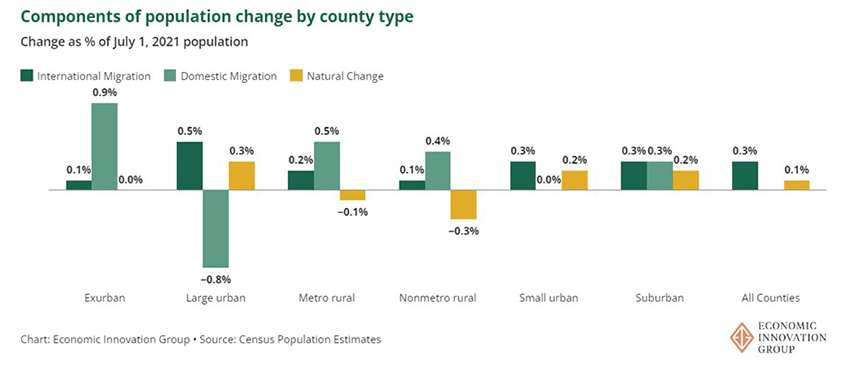
Report Cites Pandemic’s Impact on U.S, Population Shifts

(Illustration courtesy Economic Innovation Group, Washington, D.C.)
New data on county-level population changes continue to suggest that the coronavirus pandemic had profound and lasting impacts on economic geography—with two million people leaving U.S. cities between 2020 and 2022—according to a report by the Economic Innovation Group, Washington, D.C.
In the report, As Major Cities Struggle to Rebound, Remote Work Continues to Shift Population Growth, authorsAdam Ozimek and Connor O’Brien wrote though large urban counties have not yet rebounded from large population outflows experienced in 2020 and 2021, they did nearly halt overall population loss in 2022, buoyed by more normal rates of international migration.
The report said exurban and suburban counties continued to benefit from domestic migration, adding more than 800,000 new residents from other county types on net.
The report cited remote work-related factors as continuing to drive domestic population movements in 2022, though they were less important than between 2020 and 2021. Rising home prices in places with inelastic housing supplies are likely slowing migration to counties that might otherwise benefit more from remote work.

“The dominant story from last year’s county-level population trends was the Covid-era flight from big cities to suburban and exurban communities,” the report said.
The report noted revised data since 2020 shows large urban counties saw combined population losses of 812,000 between July 1, 2020 and July 1 2021. The rate of population loss in such counties slowed nearly to a halt through July 2022, a 12-month period during which urban counties saw combined declines of just 70,000 residents. Smaller urban counties bounced back somewhat, as well. In 2021, these counties saw population growth fall substantially compared to pre-pandemic rates, but did not experience an outright decline in population. In 2022, growth rates bounced back to 0.46% from 0.25% in 2021, adding 233,000 people in the last year—close to small urban counties’ growth of 0.56% in 2019. Exurban and suburban counties continued to grow the fastest in 2022 after seeing major influxes of domestic migration during the early pandemic era. These counties grew by another 832,000 in 2022 after adding 931,000 people in 2021, amounting to a 0.93% jump from 2021.
However, while domestic migration continued to boost suburbs and exurbs, a major increase in international migration shielded urban counties from larger population declines. The report cited at “dramatic bounceback” in net international migration. As restrictions on international travel were phased out and visa issuances picked up, net international migration to the U.S. nearly tripled between 2021 and 2022, from 376,000 to more one million people, the principal cause of U.S. population growth more than doubling between 2021 and 2022. Large urban counties were the main beneficiaries of increased immigration rates in 2022, adding 507,000 residents through this channel in 2022, up from 186,000 in 2021.
“Despite this modest softening of population losses, large urban counties’ population trends have still not normalized, and domestic outmigration is still well above rates experienced in the years immediately leading up to the pandemic,” EIG said. “Outflows from these counties were already dramatically accelerating over the last decade, as the nation’s largest cities confronted spiraling housing cost crises and other challenges.”
The way in which housing markets are responding to population growth may be another factor in stabilized numbers, the report said, potentially limiting domestic migration. “Housing markets are responding to remote work-driven demand shifts with higher rents and prices,” EIG said. This will be especially binding in places where housing supply is inelastic due to either zoning and geographic constraints in the long-run, or construction worker and raw materials inputs in the short-run.”
“Work-from-home related fundamentals remained important drivers of population shifts in 2022 but less than they were in 2021,” EIG said. “One reason may be that the shift to remote work early in the pandemic was a one-time shock and this led to a one-time, temporary change in migration patterns, which are now converging towards normal. Alternatively, remote work may have an impact on migration patterns that will take a longer time to unfold. In this case, the weaker relationship with work-from-home fundamentals may be due to housing supply becoming a more binding constraint to work-from-home-driven population shifts…Ultimately, the evolution of the remote work labor market and local housing markets will be crucial determinants.”
